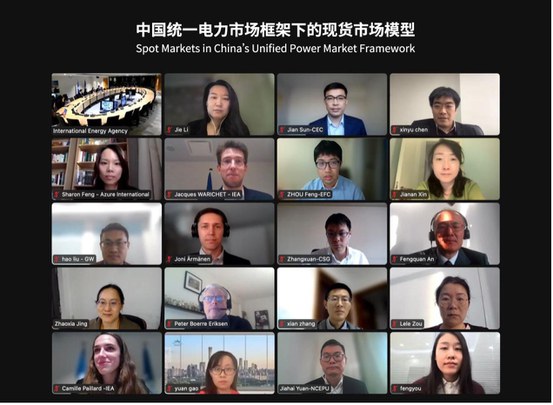EF China and IEA Hosted Discussion on China’s Electricity Spot Market
On December 6, 2022, the International Energy Agency (IEA) and Energy Foundation China (EF China) held a workshop titled “Spot Markets in China’s Unified Power Market Framework,” using this open dialogue platform to discuss a market design model proposed by IEA, as well as its transition pathways, the role of various stakeholders, and the impact of the market on each party. More than 60 experts and stakeholders from power companies, manufacturers, and research institutions attended the online meeting.

More than 60 experts attended the electricity spot market workshop held by EF China and IEA on December 6, 2022. Source: Screenshot of the online meeting.
Li Jie, EF China’s Vice President of Programs, said that more market reforms would be needed if China wants to achieve carbon neutrality in its power sector. She also voiced her hope that, by cooperating with IEA, EF China would support important scientific research and provide useful ideas and solutions for the construction of China’s new power systems and the transformations of its energy systems.
In the first session on the market design model, Sun Jian, Director of China Electricity Council’s Reform Division, shared their vision for China’s electricity spot market. He believed the future market needed to feature science-based electricity pricing, suit the characteristics of renewables, internalize their green values, guarantee the security of electricity supply, and adapt to new market players.
According to IEA Energy Analyst Camille Paillard, both the EU-like primary trading model, where regional multilateral power trading is the default model, and the secondary trading model similar to the Central American Electricity Market, where regional trading is an additional option on top of the domestic market, could be referred to, as China advances its electricity market.
Experts spoke at the following commentary session emphasized the need to transition China’s electricity market from the longer-term market to the spot market, and the coupling of markets between neighboring provinces. Chen Xinyu, professor at the School of Electrical Engineering of Huazhong University of Science and Technology, said the longer-term and spot markets could complement each other with well-designed interaction between them. Jing Zhaoxia, Vice President of the School of Electricity of South China University of Technology, said the difficulty of cross-province spot markets lies in the coordination of interests between provinces, the need to distinguish between longer-term market contracts and government-authorized contracts, and the reform of transmission pricing.
In the final roundtable discussion session on transition steps, Zhang Xuan, Deputy Director of the Policy Research Department of Southern Power Grid Beijing, suggested time-slot trading and increased trading frequency in the longer-term market. He also introduced the setup of the southern China regional electricity market. Zhang Xian, Director of the New Energy Trading Department of the Beijing Power Exchange, analyzed the role of inter-provincial spot markets play in promoting the consumption of renewables.
Other experts discussed how to connect different regional electricity markets; the pros and cons of opening up electricity markets to more participants; how electricity markets can be integrated with existing systems such as carbon markets, renewable energy quota, or green certificates; the changes affecting stakeholders in the power sector after the introduction of electricity markets; and the risks of price fluctuations. They experts included Liu Hao, Senior Expert of Goldwind’s Innovation Department; Yuan Jiahai, Professor of North China Electric Power University; He Dongquan, Director of Energy Innovation (China); and Feng Siying, Director of Research and Advisory Services at Azure International.
In his closing remarks, Fengquan An, Special Advisor of the IEA, highlighted the importance of international cooperation. He said that IEA had a long history of cooperating with China and its study on a carbon neutrality roadmap for China’s energy system set a very good example of bilateral collaboration. He very much looked forward to the continued cooperation between EF China and IEA, and also hoped that this project could lead to high quality research reports that would contribute to China’s spot market construction, energy transition, and carbon neutrality, said him.




